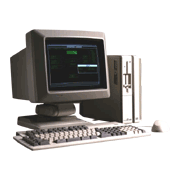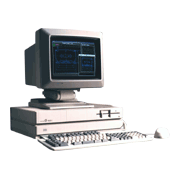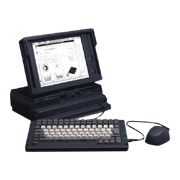This was a 32-bit business workstation from Fujitsu. Three models in the FACOM G-100 Series of business workstations (the FACOM G-140, 150 and 150A) were announced in May of 1987 as products to help solve the problem of improving office work and achieving strategic use of information. Models in this G-100 Series had the following features:
- They employed a high-performance 32-bit CPU from Motorola (the G-140 used the 16-bit M68010).
- They employed the "SX/G" high-performance OS, which was based on UNIX System V, to achieve multi-user and multi-job functionality.Operability was improved by using a uniform MMI (Man-Machine Interface).
- SX/G supported multiple windows and multiple processes as basic functions, so easy operation was achieved based on a uniform MMI for software running under SX/G.
- Office work efficiency was improved by the EPOC-G family, which was an enhancement of the EPOC family of the FACOM 9450 Series of multi-functional personal computers for business.
- They provided terminal functionality for host computers and office computers (small business computers used in offices), and tight linkage functionality based on "System Integration Architecture ".
- Total productivity of applications was improved by offering features for distributed development of host computer applications using these workstations.
Others models were introduced later, with enhanced CPU performance, larger built-in disk capacity, and greater equipment miniaturization. Of these, the lightweight and compact FACOM G-150LT laptop was particularly distinctive.
| FACOM G-140 | FACOM G-150, G-150A |
FACOM G-150LT MODEL10, MODEL30 |
|
|---|---|---|---|
| Announcement date | May 1987 | May 1989 | |
| CPU | MC68010 (10MHz) | MC68020 (16MHz) | MC68030 (16MHz) |
| Main memory | 3,4MB | 4-8MB | 4-8MB |
| Built-in disk | 44-119MB | G-150:44-269MB G-150A:44x2-238MB |
MODEL30:135-405MB MODEL10: 60-330MB |
| Display capabilities |
|
|
|
| OS | SX/G (UNIX System V based) | ||




